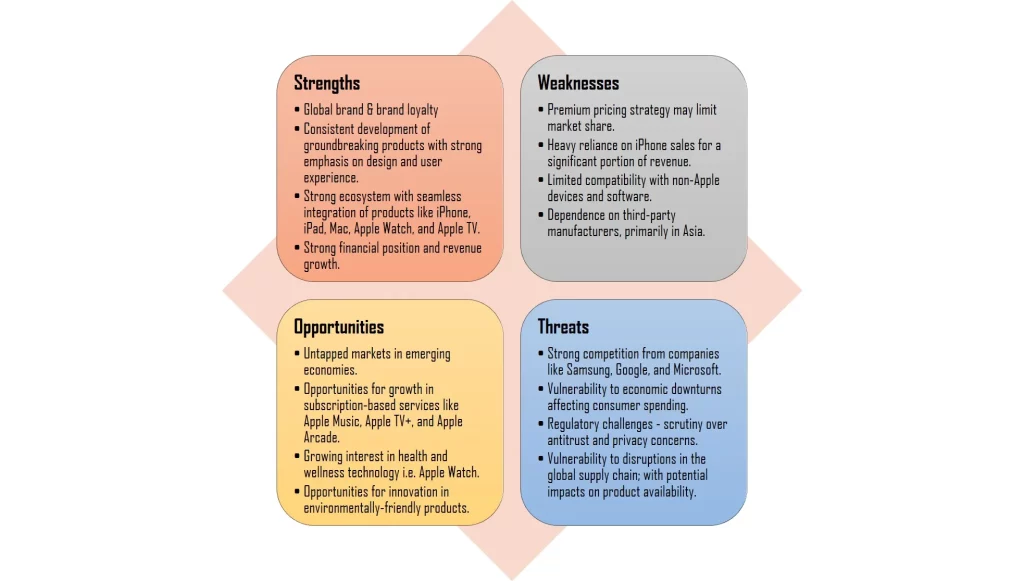
Below is a sample SWOT analysis essay on Apple, Inc. This example is intended to help students write better business analysis essays.
Apple Inc. SWOT Analysis Essay
SWOT Analysis Essay Outline: Apple Inc.
- Introduction:
- Company: Apple Inc.
- Date of Establishment: April 1, 1976
- Founders: Steve Jobs, Steve Wozniak, and Ronald Wayne
- Industry: Technology and Consumer Electronics
- Current CEO: Tim Cook (2011 – present)
- Headquarters: 1 Apple Park Way, Cupertino, California, United States
- No. of Employees: 161,000 (2023)
- Type: Public
- Ticker Symbol: AAPL (NASDAQ)
- Revenue: US $383.29 billion (2023)
- Net Income: US $97 billion (2023)
- Competitors: Alphabet Inc., Samsung Electronics Co Ltd., Microsoft Corp., Dell Technologies Inc.
- Strengths:
- Brand Strength:
- Recognized globally as a leading technology brand.
- Strong brand loyalty among consumers.
- Product Innovation:
- Consistent development of groundbreaking products.
- Strong emphasis on design and user experience.
- Ecosystem Integration:
- Seamless integration of hardware, software, and services.
- Strong ecosystem with products like iPhone, iPad, Mac, Apple Watch, and Apple TV.
- Financial Performance:
- Strong financial position and revenue growth.
- High-profit margins on products and services.
- Weaknesses:
- High Prices:
- Premium pricing strategy may limit market share.
- Vulnerability to economic downturns affecting consumer spending.
- Dependence on iPhone Sales:
- Heavy reliance on iPhone sales for a significant portion of revenue.
- Impact on overall performance if iPhone sales decline.
- Closed Ecosystem:
- Limited compatibility with non-Apple devices and software.
- Potential alienation of users from other platforms.
- Supply Chain Vulnerabilities:
- Dependence on third-party manufacturers, primarily in Asia.
- Vulnerability to supply chain disruptions.
- Opportunities:
- Global Expansion:
- Untapped markets in emerging economies.
- Growing demand for technology products worldwide.
- Service Expansion:
- Opportunities for growth in services like Apple Music, Apple TV+, and Apple Arcade.
- Expansion of subscription-based revenue streams.
- Health and Wellness Tech:
- Growing interest in health and wellness technology.
- Opportunities in products like Apple Watch and health-related software.
- Renewable Energy Initiatives:
- Increasing emphasis on sustainability and renewable energy.
- Opportunities for innovation in environmentally friendly products and practices.
- Threats:
- Intense Competition:
- Strong competition from companies like Samsung, Google, and Microsoft.
- Constant pressure to stay ahead in innovation.
- Economic Fluctuations:
- Vulnerability to economic downturns affecting consumer spending.
- Impact on sales of high-priced products.
- Regulatory Challenges:
- Scrutiny over antitrust and privacy concerns.
- Changes in international regulations affecting business operations.
- Supply Chain Disruptions:
- Vulnerability to disruptions in the global supply chain.
- Potential impact on product availability.
- Conclusion:
- Summary of key findings from the SWOT analysis.
- Implications for Apple’s strategic planning and future actions.
This outline and sample essay provides a framework for a comprehensive SWOT analysis of Apple Inc., considering its internal strengths and weaknesses, as well as external opportunities and threats in the technology market.

